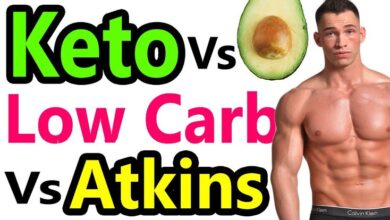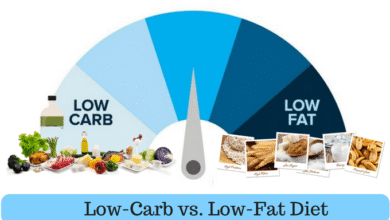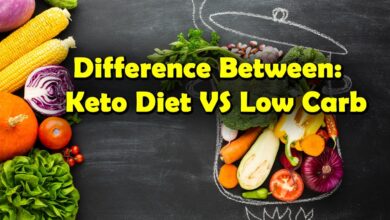
Every few years, a new diet trend takes the world by storm. For a while, it was Atkins, then Paleo, and now the most talked about rivalry seems to be between the ketogenic (keto) diet and low-fat diet. Both have millions of followers across the United States, Europe, and Africa. Both claim to be the secret to lasting weight loss, improved health, and a better life. Yet, they couldn’t be more different in philosophy. Keto tells you to embrace fats and cut carbs almost completely, while low-fat emphasizes trimming dietary fat and focusing on complex carbohydrates. With so much conflicting advice, it’s easy to feel lost. This guide dives into both approaches in detail, examining how they work, the science behind them, and most importantly—whether they can deliver the lasting results you’ve been dreaming of. By the end, you’ll know which plan fits your lifestyle and body best.
What Is the Keto Diet? Understanding the Low-Carb Revolution
The ketogenic diet, or simply keto, is built on the principle of cutting carbohydrates so drastically that your body enters a metabolic state called ketosis. In ketosis, your liver converts fat into molecules called ketones, which become your body’s primary energy source. Instead of running on glucose (from carbs), you’re running on fat. Think of it as switching from diesel to solar power—it’s a whole different fuel system.
A typical keto diet consists of about 70% fat, 20% protein, and only 10% carbs. That means foods like avocados, olive oil, salmon, eggs, cheese, nuts, and leafy greens dominate your plate. Bread, rice, pasta, and even most fruits become rare indulgences. In places like Nigeria, where staples like rice and yam are central to meals, adapting to keto often requires creativity—using alternatives like cauliflower rice or almond flour.
Keto became wildly popular in the United States after celebrities and athletes shared dramatic weight loss results. Beyond weight loss, many report benefits like reduced appetite, stable energy levels, improved mental clarity, and even better control of blood sugar. However, going keto requires discipline—because even one carb-heavy meal can knock you out of ketosis.
What Is the Low-Fat Diet? A Calorie-Control Classic
The low-fat diet takes a completely different route. Instead of cutting carbs, it reduces fat intake to about 20–30% of your daily calories. The theory is simple: since fat contains more calories per gram (9 calories) compared to protein or carbs (4 calories each), eating less fat should help reduce total calorie intake.
On a low-fat diet, you’ll find your plate filled with foods like whole grains, vegetables, legumes, lean protein, and fruits. In the US and Europe, low-fat diets have long been tied to heart health campaigns, promoting foods like oatmeal, brown rice, and whole wheat bread. In Africa, low-fat eating often aligns with traditional plant-based meals that emphasize beans, maize, vegetables, and seasonal fruits.
Supporters of low-fat diets argue that they are easier to follow long term because you don’t have to completely cut out entire food groups. Instead, the focus is on portion control, calorie awareness, and choosing healthier fats like those from olive oil, avocado, and fish. While low-fat diets don’t promise rapid weight loss like keto, they’ve been studied for decades and are often recommended by public health organizations for heart disease prevention and overall wellness【Mayo Clinic†source】.
How Do Keto and Low-Fat Diets Affect Your Body?
The biggest difference between these two diets lies in how your body processes energy. Keto forces your body into ketosis, making fat the star of the show. Low-fat diets rely on calorie control, encouraging the body to use carbohydrates for energy while keeping fat intake minimal.
Keto’s approach is like hitting the gas pedal hard—you burn fat aggressively, and the results can be quick. That’s why many people in the US, Canada, and Europe see significant changes within the first few weeks. However, the “keto flu”—a group of symptoms including headaches, fatigue, and irritability—can make the transition tough.
Low-fat diets, on the other hand, are like a steady jog instead of a sprint. Weight loss tends to be slower but more sustainable. This approach has been linked with lower cholesterol, better heart health, and reduced risk of diabetes when followed consistently【Harvard School of Public Health†source】.
The real question is not just how each diet affects your weight but also how it impacts your health, energy levels, and daily lifestyle.
Weight Loss Results: Keto vs. Low-Fat Head-to-Head
If weight loss is your number one goal, keto often delivers faster results initially. Many followers report losing 5–10 pounds in the first two weeks, largely due to water weight from carb reduction. The visible results can be motivating, making it easier to stick with the plan.
However, studies show that after 6–12 months, the weight loss difference between keto and low-fat diets becomes less significant. Both diets can work for long-term weight control, but success depends on consistency, lifestyle, and whether you can sustain the eating patterns.
Low-fat diets may not deliver the “wow factor” in the beginning, but they shine when it comes to steady progress. Many people in Europe and Africa who adopt low-fat approaches find it easier to maintain because it doesn’t require cutting out bread, rice, or fruits.
In short: keto gives you a head start, but low-fat wins in the marathon if you prefer flexibility.
The Science Behind Ketosis: Why It Works
Ketosis isn’t just a trendy buzzword—it’s a proven metabolic process. When your body doesn’t get enough glucose, it turns to stored fat for fuel. The liver produces ketones, which power your brain and muscles. This fat-burning state explains why keto diets often show dramatic results.
For people struggling with obesity or type 2 diabetes, ketosis can help improve insulin sensitivity and reduce blood sugar levels. Research even suggests keto may support brain health and reduce symptoms of neurological disorders like epilepsy.
However, ketosis isn’t risk-free. Long-term reliance on high fat intake, especially from unhealthy sources like processed meats or fried foods, can increase cholesterol and strain the liver. That’s why health experts emphasize “clean keto,” focusing on nutrient-dense fats and proteins rather than simply loading up on bacon and butter.
The Science Behind Low-Fat Diets: Why They Work
Low-fat diets are rooted in decades of research on calorie balance and cardiovascular health. Since fat is calorie-dense, lowering fat intake naturally reduces overall calorie consumption. This makes it easier to maintain a calorie deficit, which is essential for weight loss.
Beyond calories, low-fat diets emphasize whole foods rich in fiber. Fiber slows digestion, helps control hunger, and improves gut health. For example, beans, lentils, oats, and vegetables not only keep you full but also stabilize blood sugar.
Low-fat diets have also been linked with reduced cholesterol and lower risks of heart attacks and strokes. This makes them attractive to people with a family history of cardiovascular disease. In African communities where heart-related illnesses are rising, low-fat diets are increasingly recommended by nutritionists.
Which Diet Is Better for Energy and Mental Clarity?
Energy levels play a huge role in whether you stick with a diet. Many keto followers say they experience steady energy and mental clarity once their body adapts to ketosis. That’s because ketones are a more stable fuel source than glucose, which can cause energy spikes and crashes.
On the other hand, some people find the initial adaptation phase draining. During the first 1–2 weeks, they may feel sluggish and irritable, which can discourage commitment.
Low-fat diets keep glucose as the primary energy source, which feels familiar to most people. You’re less likely to experience adaptation struggles, but you may still face mid-afternoon crashes if you rely on refined carbs instead of whole grains.
Keto vs. Low-Fat: Long-Term Sustainability
The real question for most people isn’t “Which works faster?” but “Which can I stick with for life?” Keto requires strict rules and can feel socially restrictive. Going out to eat, traveling, or attending family events can be challenging when carbs are everywhere.
Low-fat diets are generally easier to maintain long-term because they allow for more food variety. You don’t have to turn down rice at a wedding in Lagos or bread at a café in London—you just balance your portions.
Sustainability matters because weight loss isn’t a one-time event—it’s a lifestyle. Whichever diet you choose, the one you can stick with consistently is the one that will work best.
Health Risks and Side Effects
Every diet comes with risks if not done correctly.
- Keto risks: Nutrient deficiencies, constipation, kidney strain, and potential cholesterol increase if fat sources are unhealthy.
- Low-fat risks: Over-reliance on processed low-fat foods, which often contain added sugars and chemicals, can backfire.
This is why professional guidance is essential. Consulting a registered dietitian or healthcare provider ensures your plan supports not just weight loss but also long-term health.
A Day on Keto vs. A Day on Low-Fat
| Meal Type | Keto Example | Low-Fat Example |
|---|---|---|
| Breakfast | Scrambled eggs with avocado and spinach | Oatmeal with banana and almond milk |
| Lunch | Grilled salmon with olive oil and broccoli | Brown rice with beans and steamed veggies |
| Dinner | Beef stir-fry with zucchini noodles | Grilled chicken with sweet potatoes and salad |
| Snacks | Almonds, cheese sticks | Apple slices, low-fat yogurt |
This simple comparison shows how differently your meals look depending on which diet you choose.
Which Diet Fits Your Lifestyle?
If you love bread, fruits, and cultural staples like rice or cassava, a low-fat diet may be more realistic. If you enjoy rich, fatty foods and don’t mind saying goodbye to carbs, keto might suit you better.
Lifestyle matters more than theory. Busy professionals in the US may prefer keto meal-prep simplicity, while African students living on campus may find low-fat diets easier with affordable staples.
What Do Experts Say?
Nutrition experts emphasize balance over extremes. While keto can be powerful for short-term weight loss and certain medical conditions, low-fat diets are often seen as safer for long-term health. Institutions like the Mayo Clinic recommend moderation, whole foods, and physical activity as the foundation of weight control.
Practical Tips for Choosing the Right Diet
- Assess your goals: Do you want quick results or long-term lifestyle change?
- Consider your health history: Diabetes, cholesterol, or heart disease risk may affect your choice.
- Test your energy response: Try each approach for 2–4 weeks and observe how your body reacts.
- Focus on quality: Avoid processed “keto” snacks or sugar-loaded “low-fat” foods.
Conclusion
The keto vs. low-fat debate doesn’t have a one-size-fits-all answer. Keto can deliver fast results and improve mental clarity, but it requires strict discipline and may not be sustainable for everyone. Low-fat diets are easier to integrate into daily life, support heart health, and work best for gradual, lasting results. The real secret isn’t picking the “perfect” diet but finding the one you can live with comfortably while maintaining balance and health.
READ ALSO Best Keto Supplements for Weight Loss and Energy: Burn Fat Faster & Stay Energized
FAQs
1. Can I switch between keto and low-fat diets?
Yes, but transitions should be gradual. Sudden shifts can cause fatigue, digestive issues, or weight fluctuations.
2. Is keto safe for everyone?
Not necessarily. People with liver, kidney, or heart conditions should consult a doctor before starting keto.
3. Do low-fat diets work for quick weight loss?
They usually lead to slower results than keto but can be equally effective in the long run.
4. Which diet is more affordable in Africa?
Low-fat diets often fit better since staples like beans, grains, and vegetables are cheaper than keto-friendly foods.
5. Can I exercise on keto?
Yes, but performance may dip initially. Many athletes adjust to keto and regain endurance over time.





One Comment